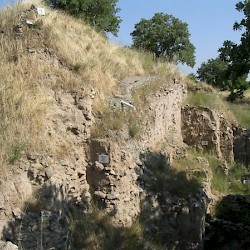Troy I-V
Q22647Ilion or Troy: town in northwestern Asia Minor, famous for the legendary Trojan War, in which a coalition of Mycenaean warriors captured the city of king Priam.Homer's Iliad deals with an episode from this war.
Maritime Troy

Maritime Troy (Troy I-III) was contemporaneous with the Old Kingdom of Egypt. Although very small, this Early Bronze Age settlement was important: situated at the entrance of the Hellespont, it was the natural place for ships to pause, before the crew would start rowing to the northeast, against the current and the perennial northwestern wind.
The village benefited from this trade and and was sufficiently wealthy to need the protection of a wall. There were remarkable, hall-like buildings in the village; they are commonly called megarons, and remained the dominant type of housing of Troy's citadel for several centuries to come.

Troy II witnessed the introduction of the potter's wheel. In other aspects, it was a continuation of the Early Bronze II culture of Troy I, albeit on a grand scale: Troy II had, for example, a splendid gateway in the southwest. But it was still a very small town, which measured just about 9,000 square meters and had a circumference of only 330 meters. (Compare the Sumerian city of Ur: 2800 meters in circumference.)
Yet, the presence of objects of gold proves that this was the seat of a local ruler who had access to the great interregional trade networks. In the southwest, an important well house was built, which was to be in use for centuries; the citadel rose over a lower town, which was surrounded by wooden defenses. It comes as no surprise that Schliemann believed that this small but powerful settlement had been the town of Priam.

To the objects excavated in Troy II belongs the set of precious objects which Schliemann called the "treasure of Priam". In his newspaper publication, he invented a romantic story about the way his wife had discovered this treasure, and the photo of Sophia Schliemann wearing the jewelry of an ancient Trojan queen or princess has become one of the most famous images of the nineteenth century.
Unfortunately, the story of the discovery is untrue, and this tall tale has often been used against Schliemann - as if modern archaeologists never overstate the importance of their finds in their press releases. It has even be argued that Schliemann had bought the objects in a local bazaar. Yet, the objects are real and can be dated to the Early Bronze II Age.
 Troy II, Priam's Treasure, headwear (replica) |
 Troy II, Priam's Treasure, diadem (replica) |
 Troy II, Priam's Treasure, axe (replica) |
 Troy II, Priam's Treasure, armwreath (replica) |
Troy II was destroyed by fire on at least three occasions. Its successor, Troy III, was essentially a continuation of Troy II: it also belonged to the Early Bronze II culture, although it was considerably smaller. It was destroyed by fire in c.2200 BCE.
Anatolian Troy
Troy IV and V belong to the Early Bronze III and Middle Bronze I periods. The people were living in what had once been the citadel of Troy II, but this town does not seem to have had an outer wall. Compared to what had happened before, this was a period of decline. Yet, the period is poorly understood, and perhaps we should postpone our judgment. Nevertheless, it is clear that the main cultural influences in this age were from the mainland, from Anatolia.
 Troy II and VI, Model |
 Troy II, Southwest wall (find spot of "Priam's Treasure") |
 Troy II, Southwest gate |
 Troy III-V, Walls |